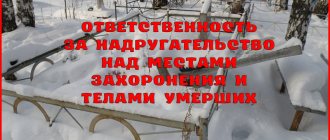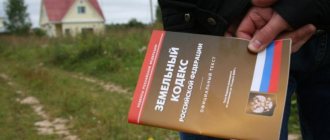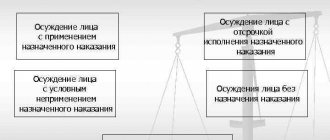Article 5 of the Federal Law of January 12, 1996 No. 8-FZ “On burial and funeral business” provides for the will of a person to treat his body with dignity after death. However, in real life it is not so simple. There are frequent cases of disputes between relatives over the ownership of a grave. The difficulty is that such a right is not registered as real estate. Conditional registration is carried out by cemeteries, which is the basis for disputes between relatives. Therefore, if you are facing a lawsuit involving a cemetery, then during the process you will need to use a lawyer with special knowledge that is available on our firm’s staff.
registration of the person responsible for the burial. legal basis
The law determines that in the absence of the will of the deceased, the right to authorize the actions specified in paragraph 1 of this article has the spouse, close relatives (children, parents, adoptive parents, siblings, grandchildren, grandparents), other relatives or the legal representative of the deceased, and in the absence of such, other persons who have taken upon themselves the responsibility to carry out the burial of the deceased.
According to Art. 6 of the Federal Law “On Burial and Funeral Affairs”, the executors of the will of the deceased are the persons indicated in his will, upon their consent to undertake the obligation to fulfill the will of the deceased. If the will of the deceased does not indicate the executors of the will, or if they refuse to execute the will of the deceased, it is carried out by the spouse, close relatives, other relatives or the legal representative of the deceased. In the event of a reasoned refusal of any of these persons to carry out the will of the deceased, it can be executed by another person who has assumed the responsibility to bury the deceased, or carried out by a specialized service for funeral matters.
In accordance with Part 1 of Art. 8 of the Federal Law “On Burial and Funeral Affairs”, the spouse, close relatives, other relatives, the legal representative of the deceased or another person who has taken upon himself the responsibility to bury the deceased are guaranteed: issuance of documents necessary for the burial of the deceased within 24 hours from the moment the cause is established of death; in cases where, in order to establish the cause of death, there are grounds for placing the body of the deceased in the morgue, the release of the body of the deceased at the request of the spouse, close relatives, other relatives, the legal representative of the deceased or another person who has assumed the responsibility to bury the deceased cannot be delayed for a period of more than two days from the moment the cause of death was established.
If we talk about Moscow, then according to clause 2.13 of Appendix No. 2 to the Decree of the Moscow Government of April 8, 2008 No. 260-PP “On the condition and measures to improve funeral services in the city of Moscow”, re-registration of the burial (re-signing of the contract) to another person , in city cemeteries, is possible only with the consent of the person responsible for the burial, and is considered in each individual case by the State Unitary Enterprise “Ritual” (GBU “Ritual”) through the administration of city cemeteries.
According to clause 2.14 of the said Appendix, the person responsible for the burial is given the right to make decisions about who will be buried in this area in the future, if the person is a spouse or close relative of the deceased (children) - children, parents, adopted children, adoptive parents, full and half brothers and sisters, grandchildren, grandfather, grandmother. If the person responsible for the burial is not a spouse or close relative of the deceased, then the decision on further burials is made on the basis of an application from the person responsible for the burial, taking into account previous burials, archival data on the degree of relationship to those buried by the State Unitary Enterprise “Ritual” commission "(GBU "Ritual").
Also according to para. 2 clause 2.1 of the Rules, a family burial is recognized as the interment of the deceased (deceased) on a plot of land in a cemetery where a spouse or close relatives (children, parents, adopted children, adoptive parents, full and half brothers and sisters, grandchildren, grandparents) had previously been buried. , or in the free space available on the site.
An example of a statement of claim to the court:
To the Savelovsky District Court of Moscow
125047, Moscow, st. Butyrsky Val 7 building 1
Plaintiff: Ivanov Ivan Ivanovich
Address: 111558, Moscow, st. 14th Parkovaya, 8 apt. 42
Place of birth Moscow tel: _______
Passport of the Russian Federation _____ issued by the department of the Federal Migration Service of Russia for the city of Moscow in the district ______
Date of issue department code _______ Taxpayer Identification Number _______
Representative of the plaintiff by proxy: Sidorov Oleg Olegovich
Passport of the Russian Federation ______ issued by: police department ________ Department of Internal Affairs Moscow. region
Place of birth: Moscow. region ______ telephone ___________ Taxpayer Identification Number __________
Registered: Moscow. region, city _________
Email address mail: _________
Defendant: State Budgetary Institution "Ritual" of Moscow
125057, Moscow, st. Peschanaya 3
State duty: 300 rub. non-property claim. The claim price is 0 rub.
court with state budgetary institution "ritual" for burial
As can already be seen, the procedure for re-registration (registration) of responsibility for burial is not the most transparent and understandable of all existing ones. However, in practice, most problems can be solved. To do this, you should consult only with professionals who have experience in resolving such cases.
Before filing a claim in court, it is necessary to clarify a number of issues, namely: the composition of the defendants (usually, this is the person recorded as responsible for the burial and cemetery - a legal entity of a unitary enterprise), the state fee (the statement of claim is not subject to assessment), the correct subject of the claim .
In Moscow, it is customary to file claims against the State Unitary Enterprise “Ritual” (GBU “Ritual”) in the Savelovsky District Court of Moscow. Contact us for help with your question and we will definitely help you!
Options for unauthorized burials
A burial is considered illegal if it is carried out:
- with the destruction of gravestone burial structures;
- sub-burial, without permission, of a coffin in a grave site while preserving the grave structures;
- by subburying, without permission, a funeral urn;
- on someone else’s family plot, often an abandoned plot is chosen;
- in violation of the boundaries of other areas or in an area of the cemetery not intended for graves;
- outside the cemetery.
Allocation of free space
in Moscow cemeteries
If an illegal burial is discovered, they contact the cemetery administration, the police and the court.
Responsibility for desecration of graves
A conviction for such a crime can carry a penalty ranging from a fine to 5 years in prison. When making a decision, the court will proceed from the totality of the circumstances of the case, as well as assess the personality of the criminal and his attitude to the crime. As already noted, a number of aggravating features are already contained in Part 2 of Art. 244 of the Criminal Code of the Russian Federation, the court has no right to take them into account again.
Special attention should be paid to the issue of the use of violence or its threat during vandalism. This rule includes in the crime the possibility of inflicting only beatings or causing minor harm to the health of the victim. If moderate or severe harm was caused during the desecration of graves, sanctions will be calculated based on the totality of Articles 244, 111 or 112 of the Criminal Code of the Russian Federation.
Inscriptions, symbols and drawings in a cemetery are punishable by at least a fine of up to 40 thousand rubles. Other actions to violate the grave and the deceased will result in punishment in the form of forced labor and even arrest for up to 3 months.
The qualified elements of the crime include restriction of freedom, forced labor, arrest for up to 6 months or 5 years of imprisonment.
Grave desecration and cemetery vandalism constitute the lowest level of moral crimes. Contempt for traditions, rituals and ceremonies is expressed through damage to both property and the feelings of living citizens towards the deceased. Responsibility under Art. 244 of the Criminal Code of the Russian Federation provides for a wide range of punishments depending on the nature of the offender’s actions. If you have any questions on this topic, you can address them to our qualified lawyers. Help is available online and by phone numbers provided.
What is the reason?
Burial of the dead is a complex process that must occur in accordance with strictly established rules. If they are not observed, buried remains may pose a danger to other people and the environmental situation in the surrounding area. The main threat is epidemiological. Decomposition products can penetrate the soil and spread with groundwater over fairly large areas.
A system of requirements has been developed for modern cemeteries, some of which are given below:
- For the burial of the dead, an area with special hydrological characteristics and topography is selected. The composition of the soil is also studied. All these factors make it possible to determine whether the burial of remains will not harm sanitary and environmental safety.
- Cemeteries are not built in places where groundwater comes close to the surface of the earth. Swampy areas and areas prone to flooding are not suitable.
- It is also not allowed to organize graveyards on the territory of sanitary and security facilities or near water sources, for example, on the banks of a river or lake.
There are many nuances that should be considered before organizing a cemetery. Only government specialists are searching for suitable territories.
For the safety and comfort of residents, when designing ritual objects, their distance from the nearest buildings and houses is also taken into account. A “green zone” is often organized around necropolises - a forested area that hides burial sites if they are in sight. Pedestrian and automobile paths must be laid in the cemetery, which will allow transporting the deceased to their burial places.
Another important reason that prevents the unauthorized burial of the deceased outside cemeteries is security considerations. Burying the dead on the territory of the graveyard allows you not to worry that something will happen to the grave. At the same time, all official burial places are entered into the accounting books, and information about them is forever preserved in the archives. If necessary, using this data it will be possible to find the lost deceased.
Vandalism at the cemetery
The general rule regulating liability for vandalism is Art. 214 of the Criminal Code of the Russian Federation. However, a special object of illegal actions (grave or cemetery buildings) requires reclassification of the act in Art. 244 of the Criminal Code of the Russian Federation.
It concerns not only individual burials in city and rural cemeteries, but also fraternal gravestones and monuments to fallen soldiers during the war. Historical monuments are of cultural value, as a result of which it is impossible even to calculate the damage from a criminal act.
Cemetery vandalism includes 2 types of criminal acts:
- violation that does not violate the integrity of the object of the crime, but prevents its further use for its main purpose;
- partial or complete destruction of an object, as a result of which its restoration or replacement is required.
Responsibility for vandalism occurs regardless of the goals and final results of the offender’s actions. It doesn’t matter whether the attacker applied an erasable inscription or destroyed the object to the ground, criminal liability will occur in both cases.
Desecration of the bodies of the dead and their burial places
It is not necessary to completely destroy the object of desecration for the court to determine the presence of corpus delicti in the actions of the attacker. It is enough to damage it or apply inscriptions, symbols or other designs.
If we are talking about the body of the deceased, then any manipulations associated with its removal from the grave are considered illegal. Thus, as a result of the crime, both immovable objects and the deceased himself may suffer. When we talk about the fact of abuse, we consider actions that contradict religious and moral principles associated with funeral and memorial traditions.
The criminal, when committing acts of desecration of graves, acts deliberately and assumes the amount of the resulting damage. It is impossible to commit desecration through negligence.
Only persons over 16 years of age will be tried for this crime according to the general rule of Art. 20 of the Criminal Code of the Russian Federation. An exception will be made for insane and incompetent persons, as well as those lagging behind in mental development compared to their physical age.
Desecration of graves includes 2 types of crimes depending on the number of aggravating circumstances. An act committed as part of a group of people, motivated by hatred or with the use of force, intimidation, transfers it from a low degree of severity to a medium one, directly increasing the penalties.






